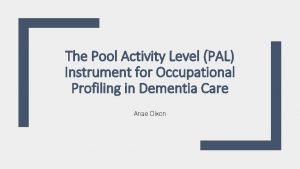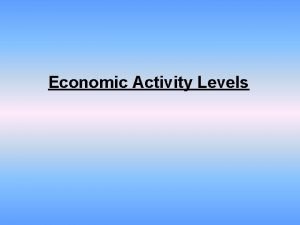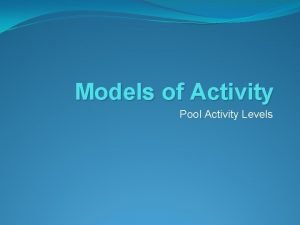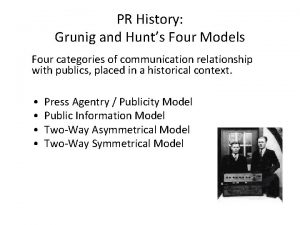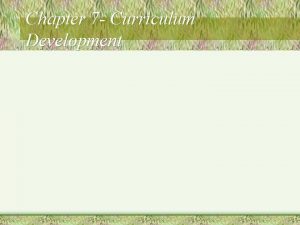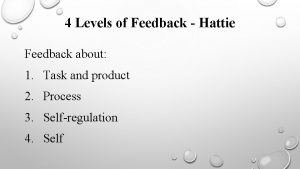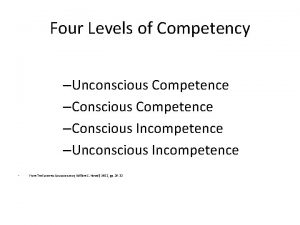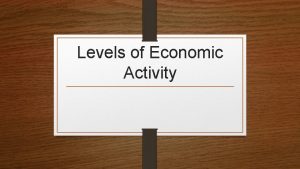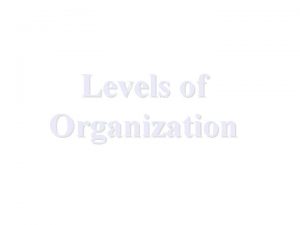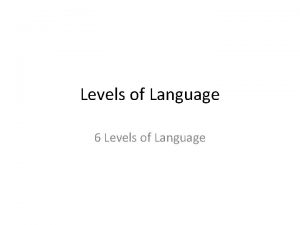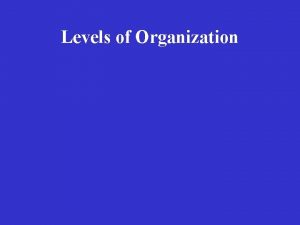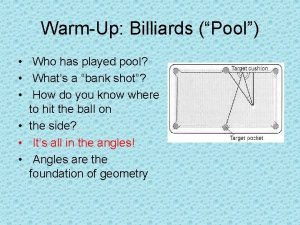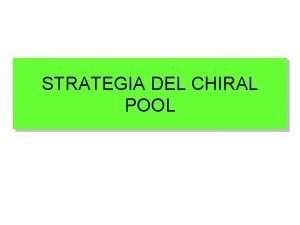Models of Activity Pool Activity Levels The Four















- Slides: 15

Models of Activity Pool Activity Levels

The Four Activity Levels �This checklist enables carers to recognise the ability of a person with cognitive impairment. �Anyone who knows the person well can complete it. �Observations should be made in several situations over a period of two weeks. �If the person lives in a group setting then the observations may need to be a compilation from all.

The Four Activity Levels �A variation of abilities and disabilities should be taken into account and an Occupational Profile can be made. �The Occupational Profile gives an overview of the way in which a person best engages in activities and how to create a facilitation environment.

The Four Activity Levels �It is usual that an individual will reveal a variation in his level of ability in different activities �The PAL instrument acknowledges how important this is and allows for a Individual Action Plan to be made that allows for a varying degree of support in some of the personal activities of daily living.

The Four Activity Levels �Many factors affect an individual’s ability to engage in an activity�Cognitive integrity �The meaningfulness of the activity �The familiarity of the environment �The support of others

The Four Activity Levels �The Pool Activity Level (PAL) is organised into four activity levels 1. 2. 3. 4. Planned activity level Exploratory activity level Sensory activity level Reflex activity level

Planned Activity Level �At this level the person can work towards completing activities but may not be able to solve any problems that arise in the process �The person will be able to look in obvious places for equipment needed but may not be able to search beyond the usual places �Carers assisting someone at this level will need to keep sentences short.

Planned Activity Level �Carers should avoid complex sentences. �Carers will need to be ready to help solve problems �People functioning at a planned activity level are able to carry out activities that achieve a tangible result.

Exploratory Activity Level �At this level the person carry out very familiar activities in familiar surroundings. �At this level people are more concerned with the effect of carrying out the activity than the consequence and may not have an end result in mind. �Carers should have a creative and spontaneous approach to the activities.

Exploratory Activity Level �If an activity involves more than two or three activities, a person at this level will need help in breaking the activity into small chunks. �Instructions need to be simple. �Memory aids can be very useful. For example, activities lists, calendars and labelling of frequently used items.

Sensory Activity Level �At this level the person may not have many thoughts or ideas about carrying out an activity. �The person is mainly concerned with sensation and with moving his or her body in response to stimulations. �People at this level can be guided to carry out singlestep activities.

Sensory Activity Level �Complex activities can only be carried out when they are directed just one step at a time. �Carers need to ensure people at this level have the opportunity to experience a wide variety of sensations and to carry out one step activities. �Directions have to be simple and reinforced with actions.

Reflex Activity Level �A person at this level may not be aware of the surrounding environment or even of his or own body. �The person is living in a subliminal or subconscious state where their movement is a reflex response to a stimulus �Carers need to enter into the person’s consciousness by using direct sensory stimulation.

Reflex Activity Level �Using direct stimulation can raise the person’s selfawareness. �People at this level may have difficulty in organising more than one sensation experience at the same time. �Multiple stimuli can cause distress, so crowds and loud noise should be avoided

Reflex Activity Level �Activities at this level should focus on introducing a single sensation to the person. �Carers need to use excellent communication skills to enter into the world of a person at this level. �Language plays only a minor role with the use of facial expression and a warm and reassuring tone and appropriate volume being vital in establishing a communication channel.
 Pool activity level dementia
Pool activity level dementia Level of economic activity
Level of economic activity What is the difference between modals and semi modals?
What is the difference between modals and semi modals? Costa's level of thinking avid
Costa's level of thinking avid Pool activity level checklist
Pool activity level checklist Cost pools
Cost pools Press agentry publicity model
Press agentry publicity model Ict architecture example
Ict architecture example Four models of clinical supervision
Four models of clinical supervision The hunkins model
The hunkins model Four market models
Four market models Four models of corporate entrepreneurship
Four models of corporate entrepreneurship Four levels of inquiry
Four levels of inquiry Levels of feedback
Levels of feedback Levels of incompetence
Levels of incompetence Verbal escalation continuum
Verbal escalation continuum
